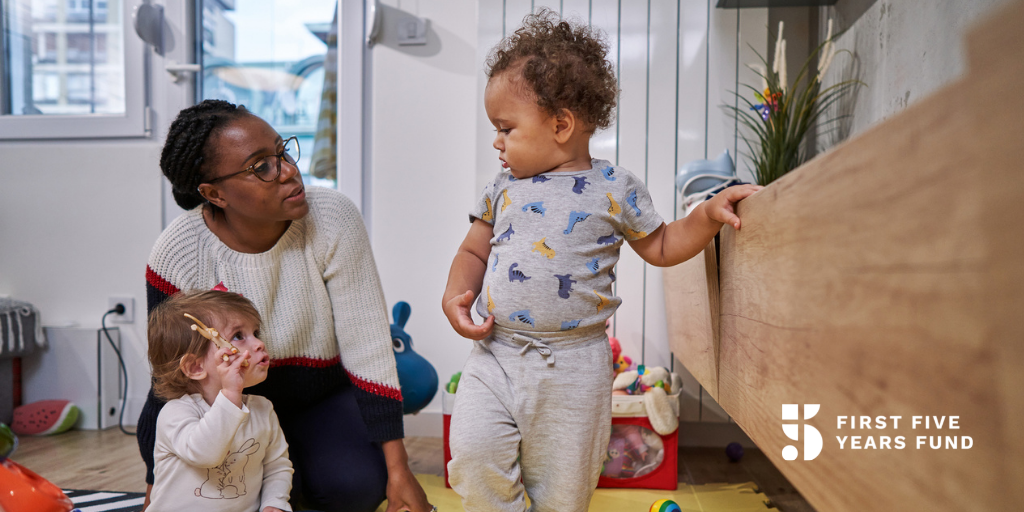Spotlighting Contributions of Latinx Educators and Inclusive Programs in the ECE Field

In honor of Hispanic Heritage Month, FFYF recognizes the immense contributions of Latinx caregivers and advocates who are working tirelessly to improve access to affordable, high-quality early care and education for young children and their families. Below are some spotlights on how Latinx caregivers, among other women of color, are the essential foundation of the nation’s early learning system, followed by examples of programs that are paving the way in terms of inclusive and culturally competent care that works best for a diversity of families, including Hispanic families.
However, more needs to be done. Despite their qualifications and contributions, caregivers are underpaid and only a fraction of eligible children are able to receive these comprehensive and needed services. Hispanic children in particular are more likely to live in a child care desert and lack access to high-quality early learning compared to their peers. Robust federal funding is needed to recruit and retain high-quality educators and ensure more children have access to needed services.
Contributions of Latinx Caregivers
Well-qualified early childhood educators are a vital component of providing high-quality early learning and care opportunities for children from birth through age five. According to a recent report by The Education Trust and The U.S. Chamber of Commerce Foundation, 94% of child care workers are women, and 40% are people of color. Hispanic women, in particular, make up a significant portion of early learning and care professionals as 25% of family-based caregivers and 14% of center-based staff identify as Hispanic. In areas with a high percentage of Hispanic students, just under half of the teachers and caregivers working in child care centers—and two-thirds of listed and unlisted home-based teachers and caregivers—are Hispanic.
While all child care professionals receive low salaries and benefits, experience high levels of poverty, and many cannot afford child care for their own children, educators of color are more likely to be at the lower end of the wage continuum, even with similar levels of education. Currently, the nation is experiencing a child care worker shortage and the sector is still down 102,400 from pre-pandemic levels, as many providers have opted for higher-paying jobs in other industries. This leaves families unable to access the care they need to go to work or school.
Supporting Young Hispanic Children and their Families
In addition to Hispanic caregivers who comprise a significant portion of the early learning landscape, Hispanic children make up roughly 1 in 4 of all children in the United States and are the fastest-growing population. In fact, this figure is projected to increase to almost 1 in 3 by 2050. It is essential to ensure that resources adequately reflect the needs of these communities and enable a strong start in life.
Children and families all require unique supports. Below are examples of a few programs that work to improve the access and quality of early learning environments for all students, with particularly strong support for Hispanic children and families.
Head Start
Many Hispanic children live in Spanish-speaking households and therefore need dual-language services and responsive language supports for families. Given there are 11.5 million dual language learning children ages birth through 8 and dual language learners (DLLs) are the fastest growing population among children, this is a crucial population to ensure are supported from birth. Research indicates that supporting bilingualism can have wide-ranging benefits, from cognitive and social advantages to long-term employment opportunities and competitiveness in the workplace later in life.
Head Start is particularly well targeted to serve DLLs, as 29% of preschool-age children enrolled in Head Start come from a home where a language other than English is spoken and, of those, 80% speak Spanish. Head Start and Early Head Start provide a variety of comprehensive services, such as developmentally, culturally, and linguistically appropriate curricula and resources specifically for DLLs. All Head Start programs have procedures in place for:
- Identifying children who are DLLs;
- Ensuring that they progress in their development and learning (including English language development),
- Making appropriate accommodations when assessing their development, and
- Providing parents of children who are dual language learners information that is in a language they understand.
Head Start also emphasizes the “whole child, whole family” in a way that recognizes the importance of multi-generational approaches, which is an especially meaningful tenant among Hispanic cultures. Grandparents and extended family members are often encouraged to participate in activities. Roughly 27% of Hispanics live in multi-generational households, and in many Hispanic families, grandparents and extended family are intimately involved in the care and education of grandchildren and family members.
While Head Start provides necessary services, they only serve a fraction of eligible children due to a lack of comprehensive federal funding. Head Start serves 36% of eligible children and Early Head Start serves 11% of eligible children.
Family Child Care Options
Home-based child care plays a major role in meeting the needs of children and families within the mixed-delivery early care and education system. Data indicates that Hispanic families, in particular, tend to utilize family child care more than center-based child care, as many prefer family child care providers who share their culture, language, and child-rearing practices. Given that Hispanic families are more likely to work nontraditional hours, the flexible nature of family child care as well as the familiar home environment and ability to care for children across age groups is helpful.
Many Hispanic families, however, are unable to access the high-quality early learning environments that work best for them. Research shows that Latino children are less likely than their non-Latino peers to be served by CCDBG, which is the largest federal funding source to help states provide child care assistance to low-income families. While 21% of eligible non-Hispanic Black children and 13% of all eligible children receive subsidies, only 8% of eligible Hispanic children receive assistance. Reasons for this disproportionate effect could be a mismatch between parents’ employment schedules and available subsidized care options, as well as some states’ requirements for documentation with immigration status and minimum weekly work hours. Policies that help make child care more affordable and available for families, especially those with low incomes, are critical for improving access to the types of child care arrangements that work best for families.
More Work Needs To Be Done To Expand Access and Address Equity
Hispanic families disproportionately live in child care deserts, where there are more than three times as many children as there are licensed child care spots. The mass exodus of child care workers due to low salaries and better job opportunities elsewhere has affected supply and further decreased already scarce child care options for families.
While the price of child care is unaffordable for many families, Hispanic families spend an especially high percentage of their income on child care even though they have some of the highest rates of employment. Immigrant Hispanic households spend 29% of their total household income on child care, and nonimmigrant Hispanic households spend 26% of household income, compared to all families who spent 15% of their income.
FFYF commends the invaluable work that Hispanic women have historically and continue to contribute to the early learning field, as well as the programs and providers that meet the unique cultural and linguistic needs of the Hispanic population. FFYF is committed to advancing equity, removing barriers, and finding meaningful, sustainable solutions to ensure efforts to support our nation’s educators rightly include the early educators who care for our youngest learners.
Subscribe to FFYF First Look
Every morning, FFYF reports on the latest child care & early learning news from across the country. Subscribe and take 5 minutes to know what's happening in early childhood education.



